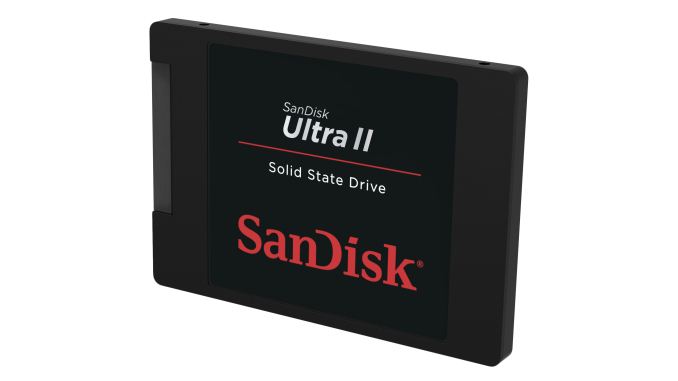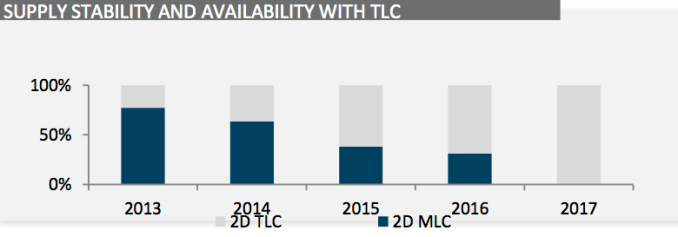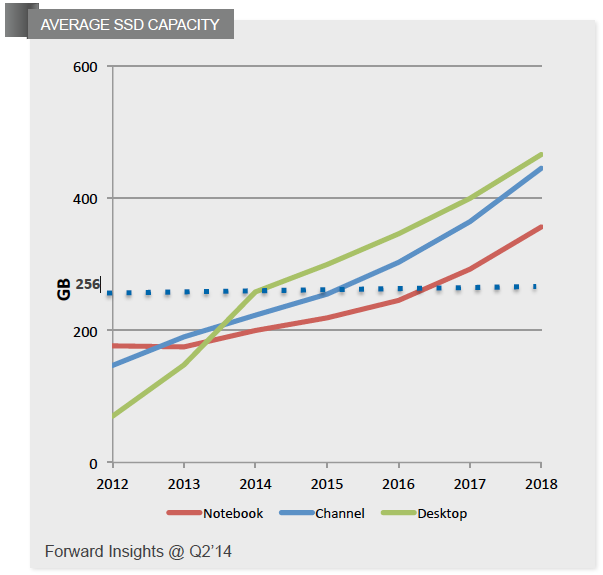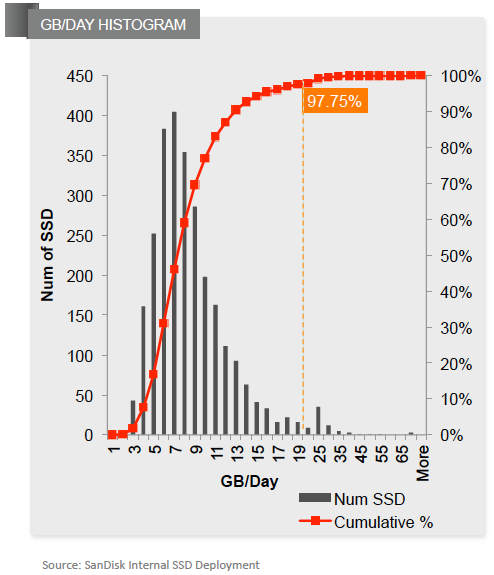The State of SanDisk
by Kristian Vättö on December 5, 2014 8:00 AM EST
Back at Flash Memory Summit I had the opportunity to meet with all the key people at SanDisk. There is a lot going on at SanDisk at the moment with the Fusion-io acquisition, TLC NAND, and other things, so I figured I would write a piece that outlines SanDisk's current situation and what they're planning for the future.
I'll start with the client side. For SanDisk the big topic at this year's Flash Memory Summit was TLC NAND and we were given a sneak peek of the SanDisk Ultra II back at the show, which was then released a few weeks later. Since we have already reviewed the Ultra II, I'm not going to talk about the drive itself and its technical merits, but there are a few things that Kevin Conley, senior vice president and general manager for SanDisk's client business brought up about TLC and the client market in general.
I'm sure most of our long-time readers remember how SSD prices plummeted between 2010 and 2012. The reason for that wasn't a breakthrough in NAND technology, but merely the fact that all manufacturers increased their manufacturing capacity with the expectation of exponential NAND demand growth. As you can see in the graph above, the industry bit growth was over 60% year-over-year between 2010 and 2012, which lead to oversupply in the market and deflated the prices.
The reason why all NAND manufacturers invested so heavily on capacity increases was the popularity of smartphones and tablets; it was expected that the average storage capacity would increase over time. Basically, the NAND manufacturers assumed that decreases in NAND prices due to smaller lithographies would translate to higher capacity smartphones and tablets, but in fact the mobile companies chose to save on onboard storage and invest in other components instead (camera, SoC, etc.).
It's only been recently that smartphone and tablet manufacturers have started to increase the internal NAND and offer higher capacity models (e.g. the 128GB iPhone 6/6+), but even today the majority of devices are shipping with 16GB, which is the same capacity that the low-end iPhone 3GS had when it was introduced in 2009. Of course a large reason for the reduced sales of higher capacity smartphones/tablets has a lot to do with pricing, where 32GB devices often cost $100 more than the 16GB model.
Since the NAND manufacturers are now adding fab space at a slower pace, they are looking for alternate ways to increase bit growth and scale costs down – and that's where TLC kicks in. Because TLC packs in 50% more bits than MLC (three bits per cell instead of two), increasing the share of TLC production is an efficient way to boost bit growth without additional fab investments.
Currently about 45-50% of SanDisk's NAND production is TLC and by next year TLC will be overtaking MLC in terms of production volume. Note that SanDisk will have 3D NAND ready in 2016, so the graph doesn't imply that SanDisk will move to TLC-only production in 2017 – it is just the 2D NAND production moving to TLC since it will mostly be used in applications like USB flash drives and other low cost devices, while 3D NAND will be used in SSDs.
TLC will also be one of the driving forces behind average capacity increase. The main obstacle in SSD adoption is obviously the cost per gigabyte, and the lower production costs of TLC will help to bring the prices down. I think it's too early to say what kind of impact TLC will have on prices because currently there are only two drives available (SanDisk's Ultra II and Samsung's 840 EVO), but once more OEMs are ready with their TLC SSDs later this year and early next year, I believe we will see more aggressive pricing.
One of SanDisk's presentations at the show had a very interesting slide about the company's internal SSD deployment program. The question that is often debated when it comes to SSD endurance is the number of gigabytes that a user writes per day. There aren't really any studies with large sample sizes, but SanDisk's own study provides an interesting insight into typical office workloads.
What the data shows is that a typical office user only writes about 7GB per day on average and the number of people that write over 20GB is only a few percent, so very few users actually need more endurance than what TLC SSDs can offer (~20GB/day). Of course, everyone's usage is different and I doubt SanDisk's data takes e.g. media professionals properly into account, but it is still interesting and valuable data nonetheless.
Another thing I discussed with SanDisk was the obstacles for higher SSD adoption rate. While there is growth, the attach rate in the consumer space is still fairly modest and will remain as such for the next few years at least. Price is obviously one of the most important factors as hard drives are still an order of magnitude cheaper when measured in price per gigabyte, but I'm not sure if absolute price and capacity are the only hurdles anymore. I mean, 256GB is more than sufficient for the majority of users – especially now that we live in the era of Netflix and Spotify – and at ~$100 it's fairly affordable, so I think we have reached a point where the price is no longer the barrier preventing users from upgrading to SSDs.
This is actually the part where we ask for your, our readers, help. What is it that we or manufacturers like SanDisk could do to boost the SSD penetration in the market? Would live demonstrations at malls and other public places help? Or upgrade programs where you could take your PC to a store and they would do the upgrade there for you? Let us know your ideas in the comment section below and I'll make sure to bring them up with SanDisk and other SSD manufacturers. Remember that we are talking about the masses here, so think about your parents for instance – what would it take for them or other people who are not very comfortable around computers to upgrade their PCs with an SSD?
The one huge problem is of course the PC OEMs and convincing them to adopt SSDs for mainstream laptops. The race to the bottom practically killed the profits in the PC industry, which is why most of the mainstream (~$400-600) laptops have such a bad user experience (low-res TN panels, cheap plastic chassis, etc...). With already razor thin margins, the OEMs are very hesitant about increasing the BOMs and taking the risk of cutting their already-near-zero margins with SSDs. I know SanDisk and other SSD OEMs have tried to lobby SSDs to the PC OEMs as much as possible, but anything that adds cost gets a highly negative response from the PC OEMs.















132 Comments
View All Comments
designerfx - Friday, December 5, 2014 - link
I concur. Price is still a barrier. SSD's provide a substantial improvement, but they are still a price premium.When 240GB SSD's get to around $50-60, we'll be at price. Until then, we explicitly aren't.
Michael Bay - Saturday, December 6, 2014 - link
This.Somewhere around 50 is the psychological barrier for an impulse buy, too.
moretoys - Friday, December 5, 2014 - link
Capacity and performance and the way operating systems are designed to me is a barrier. Most people want simple, are not techies. IMO most PCs would want performance on key things like OS boot, commonly used apps, but they also want space for long term storage, things more read than written. To use an SSD with a Hard Drive is complex to implement like this, not automated. If small SSDs could be installed and automatically take on the activities needing the performance boost without users needing to manage it, making a small SSD, practical for the masses, then they would have something.Please note I am not talking about likely 80% or more of readers here, who like me can do this themselves, but really, it is a pain.
hojnikb - Friday, December 5, 2014 - link
Windows coult implement this. When it detects an SSD and HDD combo, it should automaticly move programs and other stuff that can benefit from ssd to the actually ssd and movies/music to the HDD (Ie Documents folder to the HDD by default).SilthDraeth - Friday, December 5, 2014 - link
I work for a retail company that does upgrades like this, unfortunately we charge quite a bit unless someone has one of our "support" plans. Which all said and done isn't a bad deal for most of the masses that can't be bothered to figure out how to install a SSD. I think, if OEM started releasing more laptops with SSDs in them without a $300 premium for it, we would see more adoption as well. Seriously the majority of "regular" people PC that I work on have around 30gb of data at max. A few outliers have close to 100 GB. Instead of throwing 1tb HD into all systems, why not use 250gb SSD. Your budget machines will perform better, thus giving people a better experience and less likely to go buy brand B next time. Maybe a kiosk with a budget machine running a 5400 rpm drive, and one running an SSD. With a few easy to demonstrate programs geared to take advantage of the SSD would help.Cloakstar - Friday, December 5, 2014 - link
The way I have convinced people to purchase SSDs, especially in conjunction with a new computer:For people who use the PC for "office"-type work (Web, e-mail, Word, Excel, etc), an SSD is the one component change that will make a significant difference in computer "speed".
-An SSD responds to the computer 2 orders of magnitude (>100x) faster than an HDD, because:
-Other than a fan, the HDD is the last mechanical component in the modern PC.
-SSDs act more like RAM than the HDD.
-So, an SSD:
-Makes the computer feel much faster.
-Prevents the PC from getting slow as quickly
-Makes the computer last longer
-Is the one and only component change that can prevent the kind of slowdown your old PC is giving you. Not a "fast" CPU. Not more RAM. An SSD.
If you don't rip DVD's to your hard drive on a regular basis, a 256GB SSD is big enough, and it will make your computer feel much faster for its entire life, especially as it ages.
PeterMorgan573 - Friday, December 5, 2014 - link
I'm just about willing to opening up the box and install a new SSD, but not if it requires the operating system to be significantly tweaked for it to be used effectively. Given my 3-6 year computer replacement cycle, I'll almost certainly wait for my next computer purchase and include an SSD as well as an nTB hard drive if possible. [Probably needless to say, I've just created this account, I've been following Anand for 3 months only for background, not because I'm ever going to build my own or an enterprise system.]For new computers, a fast SSD could be cheap if its use were optimized just for fast start/restart. Not that that usage helps SSD manufacturers.
earl colby pottinger - Saturday, December 6, 2014 - link
Why do you need to tweak it.Yes, that gets max performance but I already see a huge speed up if I "DD" the hard drive over to the SSD and just plug it in as the boot drive.
All the tweaks can be done at a later time or not at-all and you still see a big speed boost.
Cerb - Sunday, December 7, 2014 - link
The operating systems already are tweaked. For Windows, just do a fresh instal to the fresh SSD. It will handle the rest. All the shenanigans some people go through are entirely unnecessary, and the few good (or bad, if you use the related features being disabed) tweaks are as good for an HDD-based system as an SSD-based one.Cliff34 - Friday, December 5, 2014 - link
Your question about how to for Sandisk to penetrate the consumer market is a hard one. At the end of the day, SSD is a geeky tech that most people do not (or will not) understand or care. For someone who is into IT, they definitely see the need and excited about the fast speed load time and transfer files. But for most consumers, they do not know worry so much about that.Unfortunately, I see this is how the adoption from CD to DVD is like. When DVD first come out, the consumers weren't crazy getting new DVD drives for their computer. They only do so because there's a need (DVD movies). They buy DVD players and not everyone rushing to bring their computer to a store to have it upgrade to a DVD drive.
Given time, price decrease and what not, DVD becomes a standard. I see is the same for SSDs. The driving market for SSDs (consumer end) is still those who are IT savy. For your consumer, like my dad who only use the laptop to read the news and watch youtube video, they don't mind the slow boot time and will not be willing to invest in a SSD. He might as well get a new computer after a few years.
The good news for us, consumers, is that through the years because of competition, the price per GB gone down significantly. But for the manufacturer, they either have to mass produce (low cost) or create very fast drives and sell at a premium to make a profit. Anything else it will be hard for them to survive.